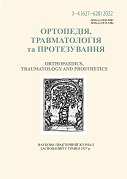The effectiveness of resistance to torsional loads of various options for osteosynthesis of bone fragments of the tibia for fractures in the upper third of the diaphysis (mathematical modeling)
DOI:
https://doi.org/10.15674/0030-598720223-445-51Keywords:
Finite element method, shank, fracture, torsion, osteosynthesisAbstract
The treatment of patients with tibial fractures and overweight has certain peculiarities due to the increased load on the osteosynthesis device. Objective. To compare the stress-strain state of models of the lower leg with a fracture of the tibia in the upper third of the diaphysis under the influence of torsional load under different options of osteosynthesis depending on the patient's weight. Methods. Using the finite element method, a fracture in the upper third of the tibia and three types of osteosynthesis were modeled: using an external fixation device (EFD), a bone plate, and an intramedullary rod. A torque of 7 Nm and 12 Nm was applied to the tibial plateau. The results. The highest indicators of the stress level in the fracture zone (6.3‒10.8 MPa) and on the metal structure (251.0‒430.2 MPa) were determined in the model with a bony plate. In the model with osteosynthesis with the help of EFD, a fairly low stress level (0.2‒0.3 MPa) was established in the fracture zone, but a high one in the proximal part of the tibia (6.7‒11.5 MPa). The lowest values of stresses in the fracture zone (0.1‒0.2 MPa) and the proximal fragment of the tibia (0.6‒1.0 MPa) were determined under the conditions of reproduction of osteosynthesis using an intramedullary rod, but in the distal part of the tibia the stresses remained quite high — 11.1‒19.0 MPa. Conclusions. The values of stresses in the fracture zone in the models with EFD and intramedullary rod were significantly lower than the values of the intact bone, with the periosteal plate - only at a load of 7 Nm. In the distal fragment of the tibia, the highest stress level was determined in the model with osteosynthesis with an intramedullary rod, in the proximal one — with EFD. Among the metal structures, the greatest stresses were found in the periosteal plate and around the fixing screws and rods under the conditions of its use. The function of the dependence of the amount of stress on the weight of the patient in the elements of the model turned out to be linear and directly proportional.
References
- WHO. Obesity and overweight [Web source]. Retrieved from https://www.who.int/news-room/fact-sheets/detail/obesity-and-overweight
- Pelypenko, O., & Kovalov, O. (2020). Analysis Of The Causes Of Mechanical Complications After Osteosynthesis Of The Limbs. The problems of traumatology and osteosynthesis, (1(19)), 47–59. https://doi.org/10.51309/2411-6858-2020-19-1-47-59
- Stoyko, I. V., Bats, V. G., Karpinsky, М. Y., & Bats, I. G. (2014). Analysis of stress-strain state of the distal tibia and foot in pilon injuries under external fixation using rod devices. TRAUMA, 15(1), 41–49. https://doi.org/10.22141/1608-1706.1.15.2014.81263
- Traore, M., Gogoua, R., Kouame, M., Yepie, A., Anoumou, M., & Varango, G. (2017). Mechanical Complications after Limb Osteosynthesis: Analysis of Etiologic Factors in 42 Cases. Open Journal of Orthopedics, 07(02), 43–52. https://doi.org/10.4236/ojo.2017.72006
- Jupiter, J. B., Ring, D., & Rosen, H. (1995). The Complications and Difficulties of Management of Nonunion in the Severely Obese. Journal of Orthopaedic Trauma, 9(5), 363–370. https://doi.org/10.1097/00005131-199505000-00001
- Karpinsky, M., Stroiev, M., Berezka, M., Hryhoruk, V., & Yaresko, O. (2022). Effectiveness of resisting torsional loads of various options for osteosynthesis of tibial fragments (according to the results of mathematical modeling). ORTHOPAEDICS, TRAUMATOLOGY and PROSTHETICS, (1-2), 34–42. https://doi.org/10.15674/0030-598720221-234-42 (in Ukrainian)
- Berezovsky, V. A., Kolotilov, N. N. (1990). Biophysical characteristics of human tis-sues: Handbook. Kyiv : Naukova dumka,. (in russian)
- Vasyuk, V. L., Koval, O. A., Karpinsky, M. Y., & Yaresko, O. V. (2019). Mathematical modeling of options for osteosynthesis of distal tibial metaphyseal fractures type C1. TRAUMA, 20(1), 28–37. https://doi.org/10.22141/1608-1706.1.20.2019.158666 (in Ukrainian)
- Korzh, M. O., Romanenko, K. K., Prozorovsky, D. V. [et al.] (2016). Mathematical modeling of the influence of the defor-mation of the lower leg bones on the load on the joints of the lower limb [Matematychne modelyuvannya vplyvu deformatsiyi kistok homilky na navantazhennya suhlobiv nyzhnʹoyi kintsivky]. Trauma (Ukraine), 17 (3), 23‒24.
- Gere, J. M., Timoshenko, S. P. (1997). Mechanics of Material.
- Zenkevich, O. K. (1978). Finite element method in engineering. Moscow : Mir. (in russian)
- Alyamovsky, A. A. (2004). SolidWorks/COSMOSWorks. Engineering analysis by the finite element method. Moscow : DMK Press. (in russian)
Downloads
How to Cite
Issue
Section
License

This work is licensed under a Creative Commons Attribution 4.0 International License.
The authors retain the right of authorship of their manuscript and pass the journal the right of the first publication of this article, which automatically become available from the date of publication under the terms of Creative Commons Attribution License, which allows others to freely distribute the published manuscript with mandatory linking to authors of the original research and the first publication of this one in this journal.
Authors have the right to enter into a separate supplemental agreement on the additional non-exclusive distribution of manuscript in the form in which it was published by the journal (i.e. to put work in electronic storage of an institution or publish as a part of the book) while maintaining the reference to the first publication of the manuscript in this journal.
The editorial policy of the journal allows authors and encourages manuscript accommodation online (i.e. in storage of an institution or on the personal websites) as before submission of the manuscript to the editorial office, and during its editorial processing because it contributes to productive scientific discussion and positively affects the efficiency and dynamics of the published manuscript citation (see The Effect of Open Access).














